Cabinet cup
In European

The decoration generally included
The shape of the porcelain body of the cups was sometimes unusual and indeed impractical; there were often two handles. The two-handled cup with a cover is called a "caudle cup" in England, but typically a "chocolate cup" for continental examples. Caudle cups were given as presents to a mother lying-in after childbirth by female friends who gathered to celebrate by consuming this alcoholic porridge-like dish.[4] Mug shapes were also used, and cabinet pieces might be sold as pairs, or sometimes available as small sets; in these cases the main paintings would be different but matching. Derby developed in the 1780s a particular saucerless type of "small straight-sided mugs generally termed 'coffee cans'", which "seem most likely have been conceived as cabinet pieces", and have some of the factory's finest painting.[5]
Most porcelain factories with a reputation for high-quality painting made at least some cabinet cups. Some supplied the unpainted bodies as "blanks" for "outside decoration" by independent
Buyers and prices

The early continental European porcelain factories relied heavily on making large and enormously expensive services for those in the court circle;[7] England, where there was little if any investment by the court, was a partial exception.[8] From around 1760 the growing prosperity of the bourgeoisie made increasing numbers able to afford smaller scale purchases of top-quality porcelain, and numbers of collectors emerged. The china cabinet already existed by the late 17th century, initially used for Japanese export porcelain and its Chinese equivalent. Cabinet pieces catered to this market,[9] but were also bought as extra pieces by the very wealthy. For example a long note of an order placed with Derby in 1791 by George IV when Prince of Wales, includes "A Cab[inet] Cup to match that left with gold sprigs" and another pair whose design is described, as well as "A Plate same as his Cab. cups...".[10]
Cabinet pieces were expensive. In 1771 "Two curious antique beakers of the fine mazarin blue ground, elegantly painted, the triumph of Bacchus, highly finish'd with burnished and chased gold" were auctioned for £21, while a 49 piece tea and coffee service fetched £7. 7s..
-
Worcester, c. 1770, an early example of a fancy Neoclassical shape
-
Sèvres cup with "M" monogram, 1798–1802, the saucer inscribed "Nettie a son amie Thim".
-
Chamberlain's factory, Worcester, c. 1805. Two-handled cup with cover, so a caudle cup type, with pastoral scene.
-
Vienna cup with cover, birds in nets and cages.
-
Pair of Derby mugs, c. 1810
-
Worcester, Chamberlain's Factory, 1807-11, with cover.
-
Sèvres cup with portrait of Louis XVIII's father,[14] saucer with the Palace of Fontainebleau, 1822–23
-
Berlin, recording a 25th wedding anniversary in 1825.[15]
Notes
- ^ Savage and Newman, 60
- ^ British Museum: "This plate was intended as a cabinet piece rather than for domestic use..."
- ^ As this Russian example from 1812 shows, Christie's; Flanders, 249
- ^ Hughes, 144
- ^ Barrett and Thorpe, 58
- ^ Savage and Newman, 60; Battie, 153, 154
- ^ Battie, 90, 100, 106–111
- ^ Battie, 115
- ^ Battie, 154
- ^ Barrett and Thorpe, 143–144
- ^ Barrett and Thorpe, 162–163
- ^ Barrett and Thorpe, 173–174
- ^ Barrett and Thorpe, 32–33, 159
- ^ King Louis XVIII died in 1824, his father Louis, Dauphin of France (1729–1765) was never king.
- ^ Commissioned by a Prussian general, Karl von Schmidt. Despite the black ground and gravestone-like monument, his wife Maria Katharine Meyer's dates are 1781–1862.
References
- Barrett, Franklin A., Thorpe, Arthur L., Derby Porcelain, 1750–1848, 1971, Faber & Faber, ISBN 0-571-09577-1
- ISBN 1-85029-251-5
- ISBN 0-00-713189-5
- Hughes, G Bernard, The Country Life Pocket Book of China, 1965, Country Life Ltd
- Savage, George, and Newman, Harold, An Illustrated Dictionary of Ceramics, 1985, Thames & Hudson, ISBN 0-500-27380-4

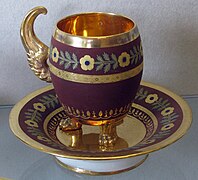
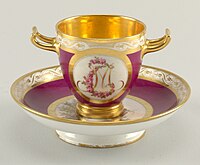
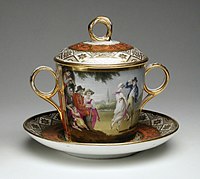
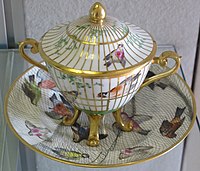
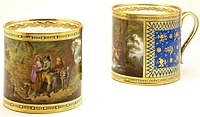
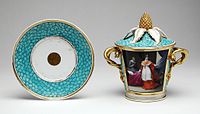
![Sèvres cup with portrait of Louis XVIII's father,[14] saucer with the Palace of Fontainebleau, 1822–23](http://upload.wikimedia.org/wikipedia/commons/thumb/d/dd/Saucer_MET_ES5484.jpg/199px-Saucer_MET_ES5484.jpg)
![Berlin, recording a 25th wedding anniversary in 1825.[15]](http://upload.wikimedia.org/wikipedia/commons/thumb/f/f8/Cup_and_saucer_MET_SLP2360a_b-1_%28cropped%29.jpg/200px-Cup_and_saucer_MET_SLP2360a_b-1_%28cropped%29.jpg)